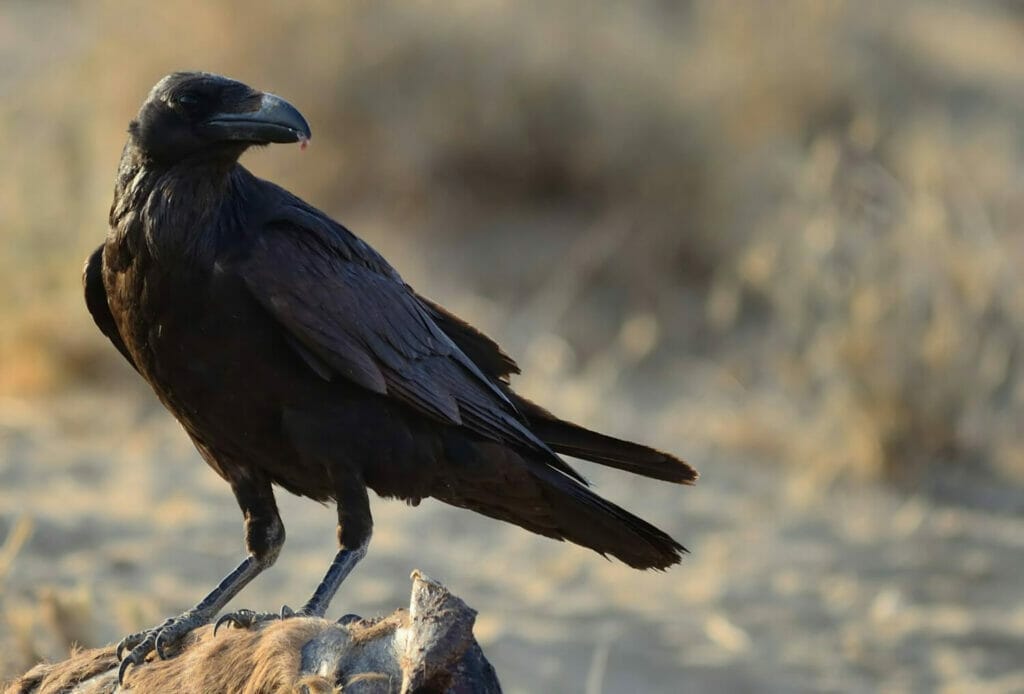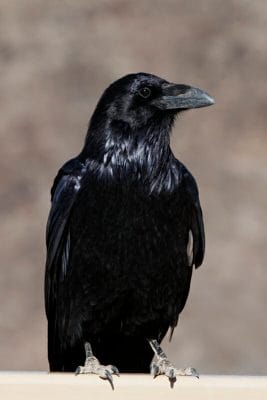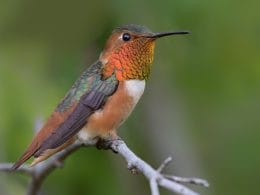Surprisingly, there are only 2 species of raven in the United States. A large area ranging from Iowa to Alabama and Florida, have no raven populations at all. The collective nouns for ravens are treachery, unkindness or conspiracy. That might be a reflection of why for hundreds of years, ravens have been treated with suspician and superstition. The reality is that these are hugely successful birds and only in recent years has their intelligence begun to be appreciated. In this post we will be looking at the raven species in the U.S. and in particular what they eat.
Common Raven (Corvus corax)

Identification
The Common Raven can be found across North America, Europe and into Asia. It is a large corvid with glossy black plumage and in flight, a wedge shaped tail is clearly seen. The base feathers are a gray color. It is well adapted to a range of environments across the Northern Hemisphere and is often seen alone or in pairs. When in a group, numbers are usually small. The call is short and guttaral but it is capable of a wide range of sounds.
Call
Range
As seen in the eBird range map below, the Common Raven is reported across a large swathe of the western United States, with concentrations in in Nevada, Arizon and California. In the east, it can be seen from Maine to Tennessee. Heading west, it is present in Michigan, Wisconsin, Minnesota and North Dakota.
The Common Raven is very adaptable and can thrive in a variety of environments. From the deserts of the south west, to east and west coastlines, the cold of the northern border and grasslands of the Pacific west or temperate east, this bird can thrive.

Feeding Behavior
Most people may assume that the main source of food for the Common Raven is carrion, either found as roadkill, scavenged in urban areas or animals in fields. Ravens do not have the ability to tear open the flesh of a recently dead animal. A carcass that is damaged by a vehicle or has begun to rot is more suitable because the flesh just falls apart. But it is not the whole story. The Common Raven is an omnivore and will eat a wide range of foods and if it is seen primarily as a scavenger, that is more to do with humans impacting on its behavior than anything instinctive.
When birds are scavenging meat, they will either pile the pieces of meat or store food in a sublingual pouch before flying away. Common Ravens they also cache foods usually low down and secured with items found close by like leaves or snow.

Types of Food
- Carrion – will actively search for roadkill and listens for other indications of animals being killed
- Live meat – will peck at the eyes of debiliatated, injured or dying animals, sometimes it will take live birds
- Eggs – will take eggs from nests if the opportunity arises
- Insects – can catch insects in flight
- Grains
- Fruit
- Rodents – will follow farm machiney looking for displaced mice or rats
- Garbarge – will roost close to potential sources of food like rubbish dumps
Chihuahuan Raven (Corvus cryptoleucus)

Identification
The Chihuahuan Raven is smaller than the Common Raven but it is easy to get them mixed up. A key difference is that the Chihuahuan Raven has white base feathers. Of course, you need some wind to find that out! This raven may also be seen in pairs but will also gather in large flocks during the winter period. The call is a short, repetitive croak.
Call
Range
The Chihuahuan Raven can be found in the south western areas of the U.S. in arid areas. Unlike the Common Raven, it does not like forests or mountains. Although the Common Raven’s range does overlap and it may be found in dry and grassland areas, the Chihuahuan Raven is the only species recognized as a desert-specialist.
During the winter, flocks of these ravens will gather and move in a southerly direction. However, they are not recognized as being migratory. the range of the Chihauhaum Raven is from western Colorado and east Kansas down through New Mexico and Texas and into Mexico itself.

Feeding Behavior
Like the Common Raven, the Chihuahuan Raven is an omnivore and will actively look for clues when searching for food. This may include following pack animals, like wolves as they hunt. Insects are their primary food source during the breeding season and in winter it is more extensive.
Chihuahuan Ravens, like their common cousins, will also store excess foods for later.

Types of Food
- Carrion – will search for rotting carcasses or take the soft parts of dying animals
- Insects – including grasshoppers, beetles, stinkbugs and worms
- Rodents – following farm machinery in case mice or rats are disturbed
- Other birds – includes domestic chickens and their eggs
- Grains – includes sorghums, corn and oats
- Fruits – desert fruits like prickly pears and hackberries
- Nuts – pecans are commonly eaten by the Chihuahuan Raven
It should be noted that the Chihuahuan Raven has not been widely studied and while it might be safe to assume it has similar feeding characteristics as the Common Raven, the effects of urbanisation on their behavior is not really known beyond anecdotal reports.

Ravens will eat or try to eat anything they can find. They are very attracted to raw meat but they will also eat fruits, vegetables and grains.
Ravens will catch rodents and other small animals if they can. There is a myth that they will attack animals like sheep and peck at their eyes. They may do this on a dead animal but are highly unlikely to attack a large live animal.
Many birds will attack anything that comes to close or appears threatening to chicks in a nest and that includes ravens and humans. Most aggression, however, is for show and they are unlikely to land a serious blow. Humans should move away from agitated birds regardless.
They are amongst the smartest birds in the world. Studies have shown that they are as capable at problem solving as highly regarded animals like dolphins and chimps.
Conclusion
Most people make assumptions about the behavior and feeding habits of ravens based on years of misinformation and supersition. The truth is that they are successful because they are intelligent, resourceful and adaptable. Being omnivorous makes them opportunists and that creates conflict with the human way of life. It is good to see that they are beginning to get the recognition they deserve.










